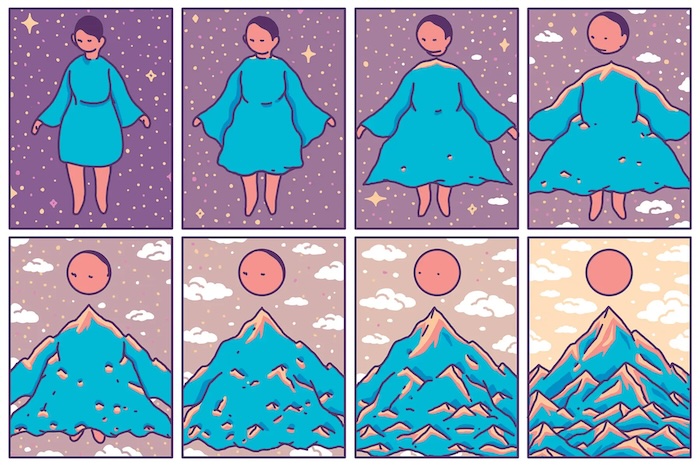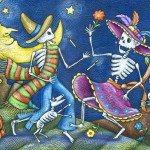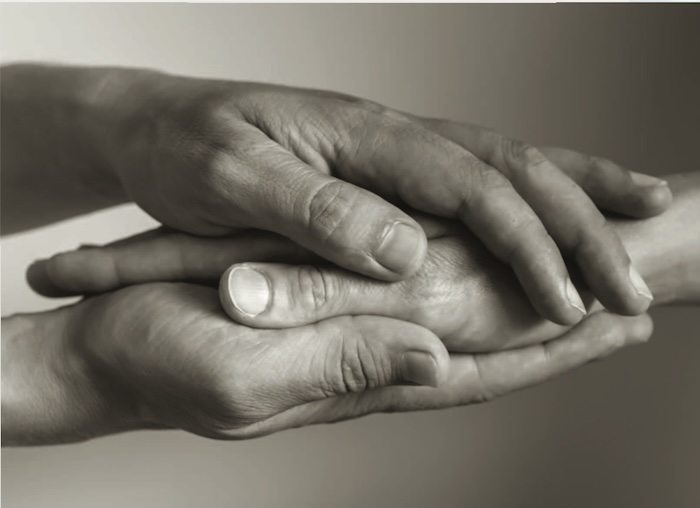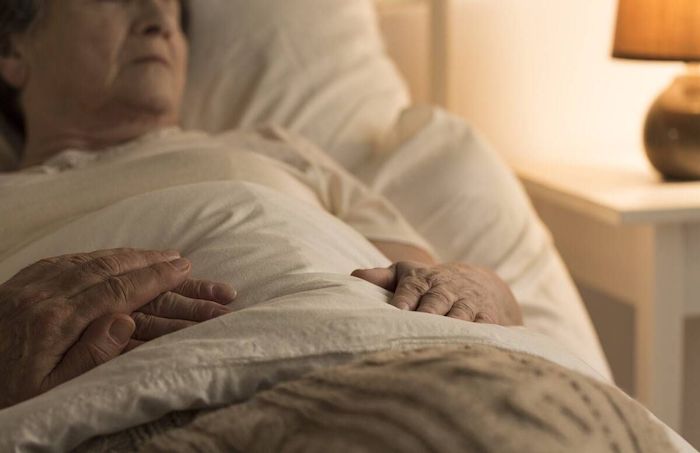— The debate over aid in dying still rages in the language that medicine and the media use to describe the practice.

By Rachel E. Gross
In rural Iowa, Peg Sandeen recalls, living with AIDS meant living under the cloud of your neighbors’ judgment. After her husband, John, fell ill in 1992, the rumors began swirling. The couple had almost learned to live with the stigma when things took a turn for the worse.
In 1993, ravaged by his disease and running out of options, John wanted to make one final decision: to die on his own terms, with the help of life-ending medication. But at the time, there was no way to convey to his doctors what he wanted. As the debate over assisted dying raged in far-off Oregon, the headlines offered up only loaded words: murder, euthanasia, suicide.
John was adamant that what he wanted was not suicide. He loved his life: his wife, who had married him even though he had asked her to leave when he learned he was H.I.V. positive; their 2-year-old daughter, Hannah; and playing Neil Young songs on guitar, a pleasure that was rapidly being taken from him as his faculties slipped away.
“This was not a man who wanted to commit suicide, at all,” said Ms. Sandeen, now the chief executive of Death With Dignity, a group that supports aid-in-dying laws across the country. To her, the word only added more judgment to the homophobia and AIDS phobia that they — and others who found themselves in a similar position — were facing.
John had expressed to his wife his wish to die on his own terms. But, to her knowledge, he never spoke about it with his physicians. At the time, it felt impossible to bring it up as simply a medical question, not a moral one.
“Even if the answer was, ‘No, we can’t offer that,’ that would have made such a difference,” she said. “We were just facing so much stigma that even to have the ability to have this end-of-life care conversation would have just been remarkable.”
John succumbed to the virus on Dec. 9, 1993, less than a year before the Death With Dignity Act passed narrowly in Oregon. Since its enactment in 1997, more than 3,700 Oregonians have taken measures permitted by the law, which allows patients with a terminal illness and the approval of two doctors to receive life-ending medication. The practice is now legal in 10 U.S. states and Washington, D.C.
With this shift has come new language. Like the Sandeens, many health advocates and medical professionals insist that a terminally ill patient taking medication to hasten the end is doing something fundamentally different from suicide. The term “medical aid in dying,” they say, is meant to emphasize that someone with a terminal diagnosis is not choosing whether but how to die.
“There is a significant, a meaningful difference between someone seeking to end their life because they have a mental illness, and someone seeking to end their life who is going to die in the very near future anyway,” said Dr. Matthew Wynia, director of the University of Colorado’s Center for Bioethics and Humanities.
In the 1990s, advocates were facing an uphill battle for support. Two assisted-dying bills, in California and Washington, had failed, and the advocates now faced an opposition campaign that mischaracterized the practice as doctor-prescribed death. “At the time, the issue very badly needed to be rebranded and repositioned,” said Eli Stutsman, a lawyer and a main author of the Death With Dignity Act. “And that’s what we did.”
The text of the law, however, only defined the practice by what it was not: mercy killing, homicide, suicide or euthanasia. (In the United States, euthanasia means that a physician actively administers the life-ending substance. That practice has never been legal in the United States, although it is in Canada.)
New terms soon became inevitable. Barbara Coombs Lee, an author of the law and president at the time of the advocacy group Compassion and Choices, remembers a meeting in 2004 where her group discussed which terminology to use going forward. The impetus “was probably another frustrated conversation about another interminable interview with a reporter who insisted on calling it suicide,” she said.
A phrase like “medical aid in dying,” they concluded, would reassure patients that they were taking part in a process that was regulated and medically sanctioned. “Medicine has that legitimating power, like it or not,” says Anita Hannig, an anthropologist at Brandeis University and author of the book “The Day I Die: The Untold Story of Assisted Dying in America.” “That really removes a lot of the stigma.”
By contrast, words like “suicide” could have a devastating effect on patients and their families, as Dr. Hannig learned in her research. Grieving relatives might be left feeling shamed, isolated or unsupported by strangers or acquaintances who assumed that the loved one had “suicided.” Dying patients often hid their true wishes from their doctors, because they feared judgment or struggled to reconcile their personal views on suicide.
Unlike an older term, “physician aid in dying,” “medical aid in dying” also centered on the patient. “This is not a decision the physician’s making — this is not even a suggestion the physician is making,” said Ms. Coombs Lee, who has worked as an emergency-room nurse and a physician assistant. “The physician’s role is really secondary.”
An equally important consideration was how the phrase would be taken up by the medical community. Doctors in Oregon were already practicing aid in dying and publishing research on it. But without agreed-upon terms, they either defaulted to “assisted suicide” (generally used by opponents of the law) or “death with dignity” (the term chosen by advocates for the name of the law). A more neutral phrase, one that doctors could use with each other and in their research, was needed.
Not all organizations today agree that “medical aid in dying” is neutral. The Associated Press Stylebook still advises referring to “physician-assisted suicide,” noting that “aid in dying” is a term used by advocacy groups. The American Medical Association also uses this language: In 2019, a report from the association’s Council on Ethical and Judicial Affairs concluded that “despite its negative connotations, the term ‘physician assisted suicide’ describes the practice with the greatest precision. Most importantly, it clearly distinguishes the practice from euthanasia.”
Medical language has long shaped — and reshaped — how we understand death. Dr. Hannig noted that the concept of brain death did not exist until 1968. Until then, a patient whose brain activity had ceased but whose heart was still beating was still legally alive. One consequence was that any doctor removing the patient’s organs for transplant would have been committing a crime — a serious concern for a profession that is notoriously fearful of lawsuits.
In 1968, a Harvard Medical School committee came to the conclusion that “irreversible coma,” now known as brain death, should be considered a new criterion for death. This new definition — a legal one, rather than a biological one — has paved the way for organ transplantation around the world. “Before the definition of death was changed, those physicians would be called murderers,” Dr. Hannig said. “Now you have a totally new definition of death.”
Of course, doctors have always assisted patients who sought a better end. But in the past, it was usually in secret and under the shroud of euphemism.
“Back in the day, before the laws were passed, it was known as a wink and a nod,” said Dr. David Grube, a retired family physician in Oregon who began prescribing life-ending medications after one of his terminally ill patient violently took his own life. He knew doctors in the 1970s and ’80s who prescribed sleeping pills to terminally ill patients and let on that combining them with alcohol would lead to a peaceful death.
For a brief time after the Death With Dignity law was passed, some doctors used the word “hastening” to emphasize that the patient was already dying and that the physician was merely nudging along an unavoidable fate. That term did not catch on, in part because hospices did not like to advertise that they were shortening lives, and patients did not like hearing that hospice care might lead to their “hastening.”
In the absence of other language, the name of the law itself became the preferred term. The phrase allowed patients to open conversations with their physicians without feeling as though they were raising a taboo subject, and doctors understood immediately what was meant. The name has stuck: Even in his retirement, Dr. Grube gets calls from patients asking to talk about “death with dignity.”
Yet in some ways, Dr. Grube believes the use of the word “dignity” was unfortunate. To him, the crucial point is not the kind of death a patient chooses, but that the patient has a choice. “You can have a dignified death when you pull out all the stops and it doesn’t work,” he said. “If that’s what you want, it’s dignified. Dignity is defined by the patient.”
To him, that means avoiding language that heaps judgment on people who are already suffering. “There’s no place for shaming language in end-of-life,” Dr. Grube said. “It shouldn’t be there.”
Complete Article ↪HERE↩!






















